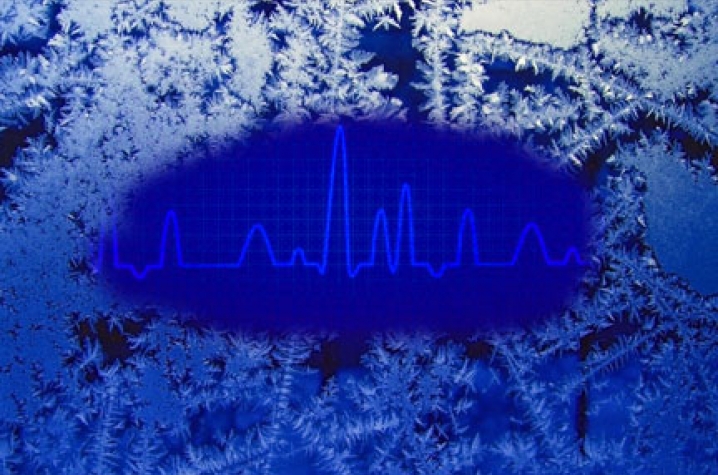A Cool Way to Restore the Rhythm
LEXINGTON, Ky. (Sept. 4, 2009) — Unless you ran up a few flights of stairs shortly before reading this, you probably haven’t noticed your heartbeat in a while (although now that I’ve mentioned it, you might find yourself checking your pulse).
Think of it like air conditioning: when it’s working, you tend to forget about it. If the room gets too hot or too cold, though, a quick check of the thermostat is in order.
Unfortunately, about one in 500 people are frequently reminded of a skipping, racing or sluggish heartbeat.
[IMAGE2]As with air conditioning, the human heart relies on a system of electrical circuits that keep the fist-sized mass of muscle, valves and vessels moving at a steady pace, pumping life-sustaining blood throughout the body.
When those circuits don’t work the way they should, it can be, at best, a nuisance. At worst, an abnormal heartbeat, or arrhythmia, can be a life-threatening disorder.
Fortunately, there are innovative and effective ways to restore the heart to a steady beat. Some of those methods are pretty cool—literally.
"We have the ability to freeze a very small area of the heart muscle in some cases," notes Dr. Samy-Claude Elayi, one of four highly-trained electrophysiologists at the UK Linda and Jack Gill Heart Institute. Others are Dr. Jignesh Shah, Dr. Shamik Aikat and Dr. Gustavo Morales.
While medication to slow a racing or fluttering heart is generally the first step in treating arrhythmia, an option for treating a misfiring circuit or extra pathway is to burn it away with heat or use a rapidly freezing gas.
This is done as a minimally-invasive, outpatient procedure in the cardiac catheterization lab at the Gill Heart Institute. The patient is first given a mild sedative and local anesthetic, and then with a small puncture in the groin or neck, the physician gently guides an electrode-tipped catheter inside the heart. Using special imaging technology, the physician is able to pinpoint the heart muscle cells that generate the faulty electrical impulses causing the abnormal heart rhythm.
In the method using radiofrequency ablation, or RF, a dose of painless radiofrequency energy, similar to microwave heat, is used to heat and destroy this carefully selected group of cells in a very small area, about 1/5 of an inch. This procedure permanently destroys the faulty pathway and stops the palpitations and “skipped” beats.
"In a majority of the patients, medications are no longer necessary after successful ablation," said Shah. "This procedure has a success rate of over 90 percent and a low risk of complications. Patients who have this done can resume normal activities in a few days."
A challenging aspect of ablation is that while the electrical mapping system shows where the abnormal pathways are, it’s difficult for physicians to determine how deep the cells lie within the heart muscle. It may help to think of a road map: It helps you find the hospital, but doesn’t necessarily tell you how tall the building is.
"What you look for is the effect you have when you burn the lesion," said Elayi. "In some patients, one burn and the arrythmia is done, gone forever. But in others, if you don’t go deep enough you may not get rid of the problem. If the catheter gets too hot, you have to stop. You can’t go on because you don’t want to damage the normal pathway which may lie very close to the abnormal one."
The Cryocath method kills the cells with freezing in two steps — a temporary freeze at a higher temperature to see if the abnormal rhythm has been affected, and if it has, a second, permanent freeze at a lower temperature can be performed. If the abnormal rhythm hasn’t been affected, the physician may opt to go a little deeper into the tissue or move to a different spot without causing irreversible damage to the tissue.
Another tool is the Thermocool catheter, which allows the physician to cool the tip of the catheter during radiofrequency ablation. This prevents the catheter from overheating and allows for deeper reach into the muscle.
"It allows us to get deeper, more effective treatment," said Elayi.
If ablation isn’t a good option for the patient, a number of devices—including watch-sized pacemakers and implantable defibrillators — are available to keep the heart beating steadily.
Patients with arrythmia often require the care of a team of heart specialists. Shah, Elayi, Morales and Aikat work closely with specialists in heart failure and various forms of heart disease at UK.
"We’re able to treat the most complex cases here,” Elayi said. “Typically the patient has other disease, and a weakened heart. It’s great having all these doctors here in one location so we can see the patients in one visit."
You may learn more about electrophysiology at UK by calling (859) 323-0295.






